Please be aware of our revised hours during the holiday season. We will operate on a half-day schedule on December 24th and 31st and will be CLOSED from December 25th to 28th, with limited customer service available. We will fully REOPEN on December 29th and again on January 2nd.
Oxytocin for men, often referred to as the “love hormone,” is a peptide that plays a crucial role in regulating emotions, improving relationships, and supporting overall health. Traditionally linked to women’s reproductive processes, recent studies have shown that oxytocin has significant benefits for men’s physical and emotional health as well. From reducing stress to enhancing intimacy, oxytocin for men can be a powerful tool for improving overall well-being.
This article will explore the many advantages of oxytocin for men, examining its role in emotional regulation, stress reduction, relationship improvement, and sexual health. By better understanding how oxytocin works in the male body, we can uncover its full potential and its possible applications in future health practices.
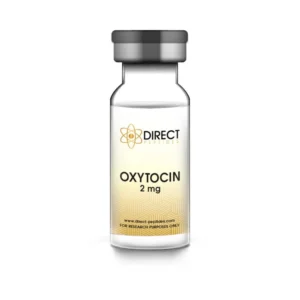 Oxytocin for men has been proven to have significant effects on emotional regulation. It plays a key role in reducing stress and anxiety by lowering cortisol levels—the body’s primary stress hormone.
Oxytocin for men has been proven to have significant effects on emotional regulation. It plays a key role in reducing stress and anxiety by lowering cortisol levels—the body’s primary stress hormone.
For men, dealing with high levels of stress is an ongoing challenge. From work pressures to personal relationships, stress can lead to various mental and physical health problems. Oxytocin offers a natural remedy to manage this stress and improve overall emotional well-being.
Discover Oxytocin Peptides from Direct Peptides , known for its ability to reduce stress, enhance emotional well-being, and improve relationship dynamics for men.
Oxytocin has been found to lower cortisol levels, which helps counteract the harmful effects of chronic stress. When cortisol levels drop, men often feel more relaxed, with a greater ability to cope with challenging situations. This process promotes emotional stability, ensuring that men can manage stressful situations with more resilience and composure.
Research has shown that oxytocin plays a significant role in calming the nervous system. This calming effect is not only beneficial for stress relief but also for improving overall mood. Men exposed to oxytocin in research settings have reported feeling less anxious and more emotionally balanced.
Explore Peptide Supplies at Direct Peptides for all your reconstitution requirements.
In addition to reducing stress, oxytocin has been shown to help reduce symptoms of anxiety. Many men struggle with anxiety, whether due to work-related stress, personal concerns, or societal pressures.
Oxytocin’s ability to promote calmness and reduce anxious thoughts can be a vital tool in helping men manage their mental health. By influencing the brain’s stress response and promoting relaxation, oxytocin supports a healthier mental state and reduces feelings of fear and tension.
Beyond its ability to regulate emotions, oxytocin for men is also a powerful peptide for building and strengthening relationships. One of its most profound effects is its ability to foster trust, empathy, and social bonding, which are essential in forming and maintaining strong, healthy relationships.
Trust is the cornerstone of any successful relationship, whether romantic, familial, or professional. Oxytocin plays a significant role in increasing trust between individuals. Research has shown that oxytocin helps individuals feel more connected and more trusting of others.
For men who may find it challenging to open up emotionally, oxytocin can make it easier to express vulnerability and build trust with others.
Oxytocin is also crucial for fostering emotional intimacy in romantic relationships. During intimate moments, oxytocin is released, which strengthens the bond between partners. For men, this release of oxytocin helps them feel more emotionally connected and intimate with their partners, which enhances the quality of their relationships.
Oxytocin can help improve communication, making it easier for men to navigate sensitive topics and maintain a deeper emotional connection.
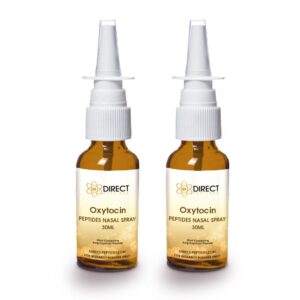 Another key benefit of oxytocin for men is its influence on sexual health. Oxytocin plays a critical role in sexual arousal, desire, and satisfaction. It not only enhances emotional intimacy but also increases sexual pleasure and performance.
Another key benefit of oxytocin for men is its influence on sexual health. Oxytocin plays a critical role in sexual arousal, desire, and satisfaction. It not only enhances emotional intimacy but also increases sexual pleasure and performance.
By boosting emotional closeness and reducing anxiety, oxytocin helps men feel more connected to their partners, which can lead to a more satisfying sexual experience.
During physical intimacy, oxytocin is released, which contributes to the feelings of closeness and arousal. For men, this release is vital in enhancing sexual desire.
Oxytocin helps regulate the body’s natural sexual responses, which can lead to more fulfilling sexual encounters. This hormonal release increases feelings of attachment and bonding, creating a positive feedback loop in sexual relationships.
Many men struggle with performance anxiety or low libido, which can negatively affect their sexual health. Oxytocin can help alleviate these issues by reducing stress and promoting emotional closeness. By making men feel more emotionally connected and less anxious, oxytocin provides a natural way to improve sexual function and satisfaction.
Oxytocin is also beneficial for cardiovascular health, a crucial aspect of overall well-being. Chronic stress and anxiety can significantly impact heart health, leading to high blood pressure, heart disease, and other cardiovascular issues. Oxytocin’s ability to reduce stress makes it a valuable tool in protecting men’s heart health.
Oxytocin’s ability to lower cortisol levels and reduce stress leads to lower blood pressure. Studies suggest that oxytocin can promote better heart health by minimizing the physiological effects of chronic stress. By improving blood flow and reducing heart rate, oxytocin plays a protective role against hypertension, which is a major risk factor for heart disease.
Stress is one of the leading contributors to cardiovascular diseases, especially in men. By promoting relaxation and lowering cortisol, oxytocin helps mitigate the damage caused by prolonged stress. For men dealing with stress-related health issues, oxytocin could help lower the risk of developing heart disease and improve overall heart function.
Men who engage in regular physical activity or bodybuilding can benefit from oxytocin’s effects on muscle recovery.
After intense exercise, muscle tissues undergo a recovery process, and oxytocin has been shown to help accelerate this process by reducing inflammation and supporting faster healing.
After a workout, muscle tissues can become inflamed, leading to soreness and extended recovery times. Oxytocin has anti-inflammatory properties that help reduce muscle inflammation, which speeds up recovery.
By promoting healing and reducing soreness, oxytocin allows men to return to physical activity more quickly, reducing the risk of injury and improving overall athletic performance.
Oxytocin also plays a role in improving physical performance. When muscle recovery is accelerated, men are able to train more frequently, push themselves harder, and improve their strength and endurance. For men looking to maximize their physical potential, oxytocin’s recovery benefits can be a crucial part of their fitness routine.
Sleep is essential for overall health, and many men suffer from sleep disorders due to stress, anxiety, or irregular sleep patterns. Oxytocin’s calming and stress-relieving properties make it a natural solution for improving sleep quality.
Oxytocin helps improve sleep by reducing anxiety and lowering cortisol levels. It promotes relaxation, making it easier for men to fall asleep and stay asleep throughout the night. For men who struggle with insomnia or disrupted sleep patterns, oxytocin provides a natural, drug-free way to achieve deeper, more restorative sleep.
Quality sleep is crucial for mental clarity, emotional stability, and physical recovery. By improving sleep quality, oxytocin indirectly supports other aspects of men’s health, including cognitive function, stress management, and overall well-being. Men who experience poor sleep due to stress or anxiety may find that oxytocin plays a key role in improving their sleep patterns and boosting their health.
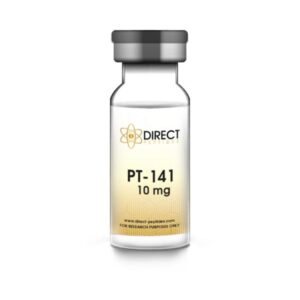 While oxytocin offers a wide range of benefits for emotional health, relationships, and physical well-being, another peptide, PT-141 (bremelanotide), can further enhance sexual health and desire. When combined, oxytocin and PT-141 may provide a more holistic solution for men seeking to improve both their emotional and physical health.
While oxytocin offers a wide range of benefits for emotional health, relationships, and physical well-being, another peptide, PT-141 (bremelanotide), can further enhance sexual health and desire. When combined, oxytocin and PT-141 may provide a more holistic solution for men seeking to improve both their emotional and physical health.
Explore PT-141 from Direct Peptides , designed to enhance sexual desire and arousal, helping men improve libido and sexual performance.
Oxytocin strengthens emotional bonds and trust, while PT-141 targets sexual arousal and performance. Together, they offer a comprehensive approach to men’s health, addressing both the emotional and physical aspects of intimacy, sexual health, and overall well-being.
For men who are looking to enhance their emotional connection with partners or improve sexual performance, this combination of peptides could offer a balanced and effective solution.
The potential benefits of oxytocin for men are only beginning to be fully understood. As research continues, scientists are uncovering more ways in which oxytocin can improve men’s health, from emotional regulation and stress relief to sexual health and muscle recovery.
As the understanding of oxytocin deepens, more clinical trials will explore its therapeutic applications for men’s health. From treating anxiety and depression to enhancing sexual health and improving heart health, the future of oxytocin in medical practices looks promising. Men may soon have access to treatments that incorporate oxytocin, offering a natural solution to a wide range of health issues.
Oxytocin for men has the potential to transform men’s health by improving emotional well-being, building stronger relationships, enhancing sexual health, and supporting cardiovascular and muscle health.
With its stress-reducing and anxiety-alleviating effects, oxytocin offers a natural solution for many of the challenges that men face today. As research continues to evolve, oxytocin could become a cornerstone in the future of men’s health, helping men lead healthier, more balanced lives.
[1] Kim YR, Kim CH, Park JH, Pyo J, Treasure J. The impact of intranasal oxytocin on attention to social emotional stimuli in patients with anorexia nervosa: a double blind within-subject cross-over experiment. PLoS One. 2014 Mar 6;9(6):e90721.
[2] Nawijn L, van Zuiden M, Koch SB, Frijling JL, Veltman DJ, Olff M. Intranasal oxytocin enhances neural processing of monetary reward and loss in post-traumatic stress disorder and traumatized controls. Psychoneuroendocrinology. 2016 Apr;66:228-37.
[3] Hurlemann R, Patin A, Onur OA, Cohen MX, Baumgartner T, Metzler S, Dziobek I, Gallinat J, Wagner M, Maier W, Kendrick KM. Oxytocin enhances amygdala-dependent, socially reinforced learning and emotional empathy in humans. J Neurosci. 2010 Apr 7;30(14):4999-5007.
[4] Feldman R. Parent-infant synchrony and the construction of shared timing; physiological precursors, developmental outcomes, and risk conditions. J Child Psychol Psychiatry. 2007 Mar-Apr;48(3-4):329-54.
[5] Gordon I, Vander Wyk BC, Bennett RH, Cordeaux C, Lucas MV, Eilbott JA, Zagoory-Sharon O, Leckman JF, Feldman R, Pelphrey KA. Oxytocin enhances brain function in children with autism. Proc Natl Acad Sci U S A. 2013 Dec 24;110(52):20953-8.
[6] Molinoff PB, Shadiack AM, Earle D, Diamond LE, Quon CY. PT-141: a melanocortin agonist for the treatment of sexual dysfunction. Ann N Y Acad Sci. 2003 Jun;994:96-102.
Shop ALL Peptide Stacks from Direct Peptides today, your trusted supplier of premium clinical grade peptides online.

Oxytocin Pre-Mixed Pen 2mg Peptide
£11.01 – £38.01Price range: £11.01 through £38.01 Select options This product has multiple variants. The options may be chosen on the product page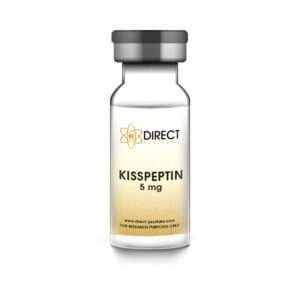
Kisspeptin Peptide Vial
£19.94 – £47.48Price range: £19.94 through £47.48 Select options This product has multiple variants. The options may be chosen on the product page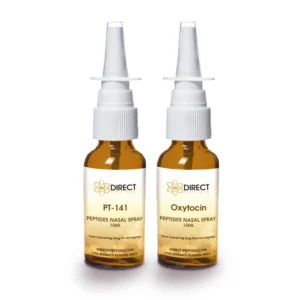
PT-141 Oxytocin Nasal Stack
£45.08 – £81.17Price range: £45.08 through £81.17 Select options This product has multiple variants. The options may be chosen on the product page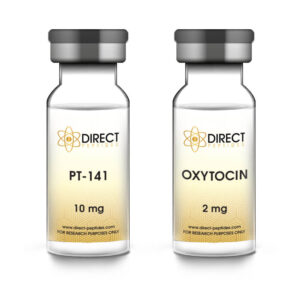
PT-141 Oxytocin Peptide Stack
£26.89 – £35.87Price range: £26.89 through £35.87 Select options This product has multiple variants. The options may be chosen on the product pageALL CONTENT AND PRODUCT INFORMATION AVAILABLE ON THIS WEBSITE IS FOR EDUCATIONAL PURPOSES ONLY.
DISCLAIMER: These products are intended solely as a research chemical only. This classification allows for their use only for research development and laboratory studies. The information available on our Direct Peptides website: https://direct-peptides.com is provided for educational purposes only. These products are not for human or animal use or consumption in any manner. Handling of these products should be limited to suitably qualified professionals. They are not to be classified as a drug, food, cosmetic, or medicinal product and must not be mislabelled or used as such.